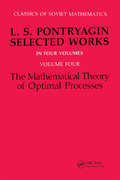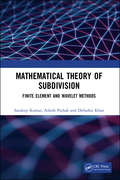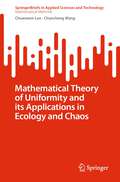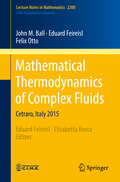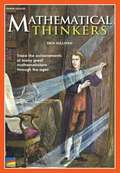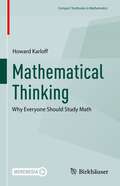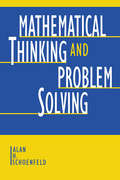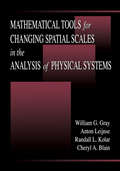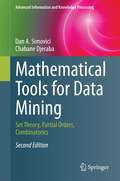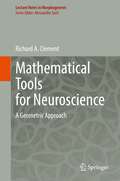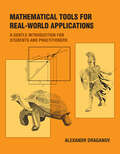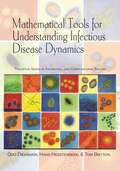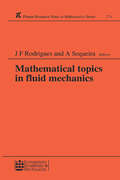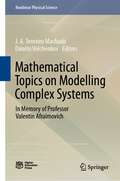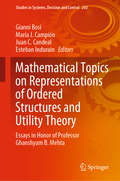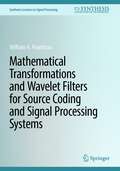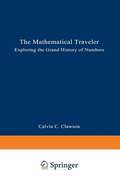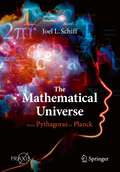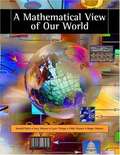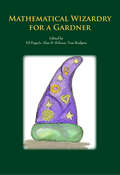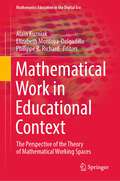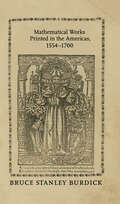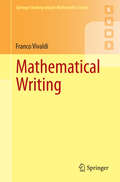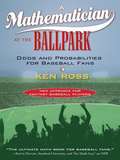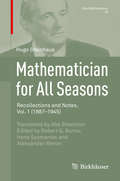- Table View
- List View
Mathematical Theory of Optimal Processes: Selected Works (Classics Of Soviet Mathematics Ser.)
by L.S. PontryaginThe fourth and final volume in this comprehensive set presents the maximum principle as a wide ranging solution to nonclassical, variational problems. This one mathematical method can be applied in a variety of situations, including linear equations with variable coefficients, optimal processes with delay, and the jump condition. As with the three preceding volumes, all the material contained with the 42 sections of this volume is made easily accessible by way of numerous examples, both concrete and abstract in nature.
Mathematical Theory of Subdivision: Finite Element and Wavelet Methods
by Sandeep Kumar Ashish Pathak Debashis KhanThis book provides good coverage of the powerful numerical techniques namely, finite element and wavelets, for the solution of partial differential equation to the scientists and engineers with a modest mathematical background. The objective of the book is to provide the necessary mathematical foundation for the advanced level applications of these numerical techniques. The book begins with the description of the steps involved in finite element and wavelets-Galerkin methods. The knowledge of Hilbert and Sobolev spaces is needed to understand the theory of finite element and wavelet-based methods. Therefore, an overview of essential content such as vector spaces, norm, inner product, linear operators, spectral theory, dual space, and distribution theory, etc. with relevant theorems are presented in a coherent and accessible manner. For the graduate students and researchers with diverse educational background, the authors have focused on the applications of numerical techniques which are developed in the last few decades. This includes the wavelet-Galerkin method, lifting scheme, and error estimation technique, etc. Features: • Computer programs in Mathematica/Matlab are incorporated for easy understanding of wavelets. • Presents a range of workout examples for better comprehension of spaces and operators. • Algorithms are presented to facilitate computer programming. • Contains the error estimation techniques necessary for adaptive finite element method. This book is structured to transform in step by step manner the students without any knowledge of finite element, wavelet and functional analysis to the students of strong theoretical understanding who will be ready to take many challenging research problems in this area.
Mathematical Theory of Uniformity and its Applications in Ecology and Chaos (SpringerBriefs in Applied Sciences and Technology)
by Chuanwen Luo Chuncheng WangThis book puts forward a new mathematical theory to study chaotic phenomenon. The uniform theory is established on the basis of two elementary concept of circle and externally tangent square in mathematics. The author studies the uniformity of a finite set of points distributed in space by uniform theory. This book also illustrates that uniform theory performs better than other indices such as entropy and Lyapunov exponent in chaos measurement by numerous examples. This book develops a new mathematical tool for studying chaos so it will be appealing to students and researchers interested in theory of chaos. It also has potential applications in various fields such as Engineering, Forestry and Ecology.
Mathematical Thermodynamics of Complex Fluids: Cetraro, Italy 2015 (Lecture Notes in Mathematics #2200)
by Elisabetta Rocca Felix OttoEduard Feireisl Eduard Feireisl John M. BallThe main goal of this book is to provide an overview of the state of the art in the mathematical modeling of complex fluids, with particular emphasis on its thermodynamical aspects. The central topics of the text, the modeling, analysis and numerical simulation of complex fluids, are of great interest and importance both for the understanding of various aspects of fluid dynamics and for its applications to special real-world problems. New emerging trends in the subject are highlighted with the intent to inspire and motivate young researchers and PhD students.
Mathematical Thinkers: Set of 6 with Teacher Materials Non Common Core Edition (Navigators Ser.)
by Erin Sullivan Alison Adams Albert HannerNIMAC-sourced textbook
Mathematical Thinking: Why Everyone Should Study Math (Compact Textbooks in Mathematics)
by Howard KarloffThis textbook invites readers to explore mathematical thinking by finding the beauty in the subject. With an accessible tone and stimulating puzzles, the author will convince curious non-mathematicians to continue their studies in the area. It has an expansive scope, covering everything from probability and graph theory to infinities and Newton’s method. Many examples of proofs appear as well, offering readers the opportunity to explore these topics with the amount of rigor that suits them. Programming exercises in Python are also included to show how math behaves in action.Mathematical Thinking is an ideal textbook for transition courses aimed at undergraduates moving from lower level to more advanced topics, as well as for math recruitment and invitational courses at the freshman or sophomore level. It may also be of interest in computer science departments and can be used as a supplemental text for courses in discrete mathematics and graph theory.
Mathematical Thinking and Problem Solving (Studies in Mathematical Thinking and Learning Series)
by Alan H. SchoenfeldIn the early 1980s there was virtually no serious communication among the various groups that contribute to mathematics education -- mathematicians, mathematics educators, classroom teachers, and cognitive scientists. Members of these groups came from different traditions, had different perspectives, and rarely gathered in the same place to discuss issues of common interest. Part of the problem was that there was no common ground for the discussions -- given the disparate traditions and perspectives. As one way of addressing this problem, the Sloan Foundation funded two conferences in the mid-1980s, bringing together members of the different communities in a ground clearing effort, designed to establish a base for communication. In those conferences, interdisciplinary teams reviewed major topic areas and put together distillations of what was known about them.* A more recent conference -- upon which this volume is based -- offered a forum in which various people involved in education reform would present their work, and members of the broad communities gathered would comment on it. The focus was primarily on college mathematics, informed by developments in K-12 mathematics. The main issues of the conference were mathematical thinking and problem solving.
Mathematical Tools for Changing Scale in the Analysis of Physical Systems
by William G. Gray Anton Leijnse Randall L. Kolar Cheryl A. BlainMathematical Tools for Changing Scale in the Analysis of Physical Systems presents a new systematic approach to changing the spatial scale of the differential equations describing science and engineering problems. It defines vectors, tensors, and differential operators in arbitrary orthogonal coordinate systems without resorting to conceptually difficult Riemmann-Christoffel tensor and contravariant and covariant base vectors. It reveals the usefulness of generalized functions for indicating curvilineal, surficial, or spatial regions of integration and for transforming among these integration regions. These powerful mathematical tools are harnessed to provide 128 theorems in tabular format (most not previously available in the literature) that transform time-derivative and del operators of a function at one scale to the corresponding operators acting on the function at a larger scale. Mathematical Tools for Changing Scale in the Analysis of Physical Systems also provides sample applications of the theorems to obtain continuum balance relations for arbitrary surfaces, multiphase systems, and problems of reduced dimensionality. The mathematical techniques and tabulated theorems ensure the book will be an invaluable analysis tool for practitioners and researchers studying balance equations for systems encountered in the fields of hydraulics, hydrology, porous media physics, structural analysis, chemical transport, heat transfer, and continuum mechanics.
Mathematical Tools for Data Mining
by Dan A. Simovici Chabane DjerabaData mining essentially relies on several mathematical disciplines, many of which are presented in this second edition of this book. Topics include partially ordered sets, combinatorics, general topology, metric spaces, linear spaces, graph theory. To motivate the reader a significant number of applications of these mathematical tools are included ranging from association rules, clustering algorithms, classification, data constraints, logical data analysis, etc. The book is intended as a reference for researchers and graduate students. The current edition is a significant expansion of the first edition. We strived to make the book self-contained and only a general knowledge of mathematics is required. More than 700 exercises are included and they form an integral part of the material. Many exercises are in reality supplemental material and their solutions are included.
Mathematical Tools for Neuroscience: A Geometric Approach (Lecture Notes in Morphogenesis)
by Richard A. ClementThis book provides a brief but accessible introduction to a set of related, mathematical ideas that have proved useful in understanding the brain and behaviour. If you record the eye movements of a group of people watching a riverside scene then some will look at the river, some will look at the barge by the side of the river, some will look at the people on the bridge, and so on, but if a duck takes off then everybody will look at it. How come the brain is so adept at processing such biological objects? In this book it is shown that brains are especially suited to exploiting the geometric properties of such objects. Central to the geometric approach is the concept of a manifold, which extends the idea of a surface to many dimensions. The manifold can be specified by collections of n-dimensional data points or by the paths of a system through state space. Just as tangent planes can be used to analyse the local linear behaviour of points on a surface, so the extension to tangent spaces can be used to investigate the local linear behaviour of manifolds. The majority of the geometric techniques introduced are all about how to do things with tangent spaces.Examples of the geometric approach to neuroscience include the analysis of colour and spatial vision measurements and the control of eye and arm movements. Additional examples are used to extend the applications of the approach and to show that it leads to new techniques for investigating neural systems. An advantage of following a geometric approach is that it is often possible to illustrate the concepts visually and all the descriptions of the examples are complemented by comprehensively captioned diagrams.The book is intended for a reader with an interest in neuroscience who may have been introduced to calculus in the past but is not aware of the many insights obtained by a geometric approach to the brain. Appendices contain brief reviews of the required background knowledge in neuroscience and calculus.
Mathematical Tools for Real-World Applications: A Gentle Introduction for Students and Practitioners
by Alexandr DraganovTechniques for applying mathematical concepts in the real world: six rarely taught but crucial tools for analysis, research, and problem-solving.Many young graduates leave school with a solid knowledge of mathematical concepts but struggle to apply these concepts in practice. Real scientific and engineering problems are different from those found in textbooks: they are messier, take longer to solve, and standard solution recipes might not apply. This book fills the gap between what is taught in the typical college curriculum and what a practicing engineer or scientist needs to know. It presents six powerful tools for analysis, research, and problem-solving in the real world: dimensional analysis, limiting cases, symmetry, scaling, making order of magnitude estimates, and the method of successive approximations. The book does not focus on formulaic manipulations of equations, but emphasizes analysis and explores connections between the equations and the application. Each chapter introduces a set of ideas and techniques and then shows how these techniques apply to a series of problems. (Knowledge of algebra and trigonometry, but not calculus, is required.) The final two chapters tie all six techniques together and apply them to two real-world problems: computing the probability of a rare, catastrophic event, and tracking a satellite with a GPS receiver. Readers will learn how to analyze, dissect, and gain insight into the results by using all the techniques presented in earlier chapters—and discover how analysis tools work on problems not concocted for a textbook. The appendix provides solutions to many of the problems found throughout the book. Alexandr Draganov was born and raised in Kyiv, Ukraine; in light of the current war in Ukraine he will donate 100% of his royalties for the first year to support medical and humanitarian efforts there.
Mathematical Tools for Understanding Infectious Disease Dynamics (Princeton Series in Theoretical and Computational Biology #7)
by Odo Diekmann Hans Heesterbeek Tom BrittonMathematical modeling is critical to our understanding of how infectious diseases spread at the individual and population levels. This book gives readers the necessary skills to correctly formulate and analyze mathematical models in infectious disease epidemiology, and is the first treatment of the subject to integrate deterministic and stochastic models and methods.Mathematical Tools for Understanding Infectious Disease Dynamics fully explains how to translate biological assumptions into mathematics to construct useful and consistent models, and how to use the biological interpretation and mathematical reasoning to analyze these models. It shows how to relate models to data through statistical inference, and how to gain important insights into infectious disease dynamics by translating mathematical results back to biology. This comprehensive and accessible book also features numerous detailed exercises throughout; full elaborations to all exercises are provided.Covers the latest research in mathematical modeling of infectious disease epidemiologyIntegrates deterministic and stochastic approachesTeaches skills in model construction, analysis, inference, and interpretationFeatures numerous exercises and their detailed elaborationsMotivated by real-world applications throughout
Mathematical Topics in Fluid Mechanics: Proceedings Of The Summer Course Held In Lisbon, Portugal, September 9-13, 1991 (Pitman Research Notes In Mathematics Ser.)
by Jose Francisco Rodrigues Adelia SequeiraThis Research Note presents several contributions and mathematical studies in fluid mechanics, namely in non-Newtonian and viscoelastic fluids and on the Navier-Stokes equations in unbounded domains. It includes review of the mathematical analysis of incompressible and compressible flows and results in magnetohydrodynamic and electrohydrodynamic stability and thermoconvective flow of Boussinesq-Stefan type. These studies, along with brief communications on a variety of related topics comprise the proceedings of a summer course held in Lisbon, Portugal in 1991. Together they provide a set of comprehensive survey and advanced introduction to problems in fluid mechanics and partial differential equations.
Mathematical Topics on Modelling Complex Systems: In Memory of Professor Valentin Afraimovich (Nonlinear Physical Science)
by J. A. Tenreiro Machado Dimitri VolchenkovThis book explores recent developments in theoretical research and mathematical modelling of real-world complex systems, organized in four parts. The first part of the book is devoted to the mathematical tools for the design and analysis in engineering and social science study cases. We discuss the periodic evolutions in nonlinear chemical processes, vibro-compact systems and their behaviour, different types of metal–semiconductor self-assembled samples, made of silver nanowires and zinc oxide nanorods. The second part of the book is devoted to mathematical description and modelling of the critical events, climate change and robust emergency scales. In three chapters, we consider a climate-economy model with endogenous carbon intensity and the behaviour of Tehran Stock Exchange market under international sanctions. The third part of the book is devoted to fractional dynamic and fractional control problems. We discuss the novel operational matrix technique for variable-order fractional optimal control problems, the nonlinear variable-order time fractional convection–diffusion equation with generalized polynomials The fourth part of the book concerns solvability and inverse problems in differential and integro-differential equations. The book facilitates a better understanding of the mechanisms and phenomena in nonlinear dynamics and develops the corresponding mathematical theory to apply nonlinear design to practical engineering. It can be read by mathematicians, physicists, complex systems scientists, IT specialists, civil engineers, data scientists and urban planners.
Mathematical Topics on Representations of Ordered Structures and Utility Theory: Essays in Honor of Professor Ghanshyam B. Mehta (Studies in Systems, Decision and Control #263)
by Gianni Bosi María J. Campión Juan C. Candeal Esteban IndurainThis book offers an essential review of central theories, current research and applications in the field of numerical representations of ordered structures. It is intended as a tribute to Professor Ghanshyam B. Mehta, one of the leading specialists on the numerical representability of ordered structures, and covers related applications to utility theory, mathematical economics, social choice theory and decision-making. Taken together, the carefully selected contributions provide readers with an authoritative review of this research field, as well as the knowledge they need to apply the theories and methods in their own work.
Mathematical Transformations and Wavelet Filters for Source Coding and Signal Processing Systems (Synthesis Lectures on Signal Processing)
by William A. PearlmanThis book teaches the fundamentals and mathematical formulas of reversible transformations (or transforms) that are used in many source coding and signal processing systems. These mathematical transforms are often necessary or crucial toward reduction of data storage and transmission rate requirements. The author emphasizes the wavelet transform as it is the preferred transform for practical application in many coding and signal processing systems. The book also covers the tap (coefficient) values for some of those filters that satisfy the perfect reconstruction property. Examples of the use of filter-based and matrix-based transforms are also provided. This self-contained work contains insight gained through research and practice, which makes it a valuable reference and tutorial for readers interested in the subject of mathematical transforms.This book:Teaches the fundamentals and mathematical formulas of reversible transformations, as well as their applicationsHighlights the wavelet transformation, which is the preferred transform for many practical applicationsContains insight gained through research and practice, making it a valuable resource those interested in the topic
Mathematical Traveler: Exploring The Grand History Of Numbers
by Calvin C. ClawsonThe story of numbers is a rich, sweeping history that shows how our mathematical achievements contributed to the greatest innovations of civilization. Calvin Clawson, acclaimed author of Conquering Math Phobia, weaves a story of numbers that spans thousands of years. As Clawson so clearly shows, numbers are not only an intrinsic and essential thread in our modern lives, but have always been an integral part of the human psyche - knit into the very fabric of our identity as humans. Clawson travels back through time to the roots of the history of numbers. In exploring early human fascination with numbers, he unearths the clay beads, knotted ropes, and tablets used by our ancestors as counting tools. He then investigates how numeric symbols and concepts developed uniquely and independently in Meso-America, China, and Egypt. As he persuasively argues, the mathematical concepts that arose and flourished in the ancient world enabled the creation of architectural masterpieces as well as the establishment of vast trade networks. Continuing the journey, Clawson brings us to the elegant logic of numbers that soon came to distinguish itself as a discipline and the language of science. From the concepts of infinity contemplated by the Greeks to the complex numbers that are indispensable to scientists on the cutting edge of research today, Clawson breathes life and meaning into the history of great mathematical mysteries and problems. In this spirit of inquiry, he explores, in their times and places, the discovery of numbers that lie outside the province of counting, including irrational numbers, transcendentals, complex numbers, and the enormous transfinite numbers. The personalities and the creative feats surrounding each mathematical invention come alive vividly in Clawson's lucid prose. In this work of breathtaking scope, Clawson guides us through the wonders of numbers and illustrates their monumental impact on civilization.
The Mathematical Universe: From Pythagoras to Planck (Springer Praxis Books)
by Joel L. SchiffI first had a quick look, then I started reading it. I couldn't stop. -Gerard 't Hooft (Nobel Prize, in Physics 1999)This is a book about the mathematical nature of our Universe. Armed with no more than basic high school mathematics, Dr. Joel L. Schiff takes you on a foray through some of the most intriguing aspects of the world around us. Along the way, you will visit the bizarre world of subatomic particles, honey bees and ants, galaxies, black holes, infinity, and more. Included are such goodies as measuring the speed of light with your microwave oven, determining the size of the Earth with a stick in the ground and the age of the Solar System from meteorites, understanding how the Theory of Relativity makes your everyday GPS system possible, and so much more. These topics are easily accessible to anyone who has ever brushed up against the Pythagorean Theorem and the symbol π, with the lightest dusting of algebra. Through this book, science-curious readers will come to appreciate the patterns, seeming contradictions, and extraordinary mathematical beauty of our Universe.
A Mathematical View of Our World
by Harold Parks Gary Musser Lynn Trimpe Roger Maurer Vikki MaurerHighlighting the connections and patterns of mathematics in everyday life, this textbook explains the mathematics of choice, management applications, basic statistics and probability, and how growth and decay relate to finance. Topics include voting systems, project scheduling, picturing data, survey sampling methods, and Malthusian population growth.
Mathematical Wizardry for a Gardner
by Ed Pegg Jr. Alan H. Schoen Tom RodgersIn this volume, world-leading puzzle designers, puzzle collectors, mathematicians, and magicians continue the tradition of honoring Martin Gardner, who inspired them to enter mathematics, to enter magic, to bring magic into their mathematics, or to bring mathematics into their magic. This edited collection contains a variety of articles connected t
Mathematical Work in Educational Context: The Perspective of the Theory of Mathematical Working Spaces (Mathematics Education in the Digital Era #18)
by Alain Kuzniak Elizabeth Montoya-Delgadillo Philippe R. RichardThis book is a friendly and complete introduction to one of the most comprehensive contemporary theories of mathematics teaching and learning. By focusing on mathematical work performed by students and teachers during mathematics session, the theory of Mathematical Workings Spaces (MWS) has opened up new perspectives and avenues on mathematics education and mathematical thinking. In particular, it enables the identification of students' knowledge production processes and helps teachers to shape them. The first part of the book explores the heart of the theory and aims to further describe and understand epistemological and cognitive aspects of mathematical work. The second part develops the different MWS dedicated to observing how this work depends on the expectations of educational systems, how it is formed and taught, and how individuals appropriate it. In the last part, some applications and perspectives are discussed regarding topics of major importance today in mathematics education which relate to technological and digital tools, teacher training and modeling activities. In line with the spirit of the theory, the book was written to reflect the conceptual unity at the heart of the theory of MWS and, at the same time, to show the freedom and diversity of approaches given space therein. Written for researchers and professionals in mathematics education, it offers plenty of concrete examples from different educational systems around the world to illustrate the theoretical concepts and show the applicability of the theory to practice and research.
Mathematical Works Printed in the Americas, 1554–1700 (Johns Hopkins Studies in the History of Mathematics)
by Bruce Stanley BurdickThis magisterial annotated bibliography of the earliest mathematical works to be printed in the New World challenges long-held assumptions about the earliest examples of American mathematical endeavor. Bruce Stanley Burdick brings together mathematical writings from Mexico, Lima, and the English colonies of Massachusetts, Pennsylvania, and New York. The book provides important information such as author, printer, place of publication, and location of original copies of each of the works discussed. Burdick’s exhaustive research has unearthed numerous examples of books not previously cataloged as mathematical. While it was thought that no mathematical writings in English were printed in the Americas before 1703, Burdick gives scholars one of their first chances to discover Jacob Taylor’s 1697 Tenebrae, a treatise on solving triangles and other figures using basic trigonometry. He also goes beyond the English language to discuss works in Spanish and Latin, such as Alonso de la Vera Cruz's 1554 logic text, the Recognitio Summularum; a book on astrology by Enrico Martínez; books on the nature of comets by Carlos de Sigüenza y Góngora and Eusebio Francisco Kino; and a 1676 almanac by Feliciana Ruiz, the first woman to produce a mathematical work in the Americas. Those fascinated by mathematics, its history, and its culture will note with interest that many of these works, including all of the earliest ones, are from Mexico, not from what is now the United States. As such, the book will challenge us to rethink the history of mathematics on the American continents.
Mathematical Writing
by Franco VivaldiThis book teaches the art of writing mathematics, an essential -and difficult- skill for any mathematics student. The book begins with an informal introduction on basic writing principles and a review of the essential dictionary for mathematics. Writing techniques are developed gradually, from the small to the large: words, phrases, sentences, paragraphs, to end with short compositions. These may represent the introduction of a concept, the abstract of a presentation or the proof of a theorem. Along the way the student will learn how to establish a coherent notation, mix words and symbols effectively, write neat formulae, and structure a definition. Some elements of logic and all common methods of proofs are featured, including various versions of induction and existence proofs. The book concludes with advice on specific aspects of thesis writing (choosing of a title, composing an abstract, compiling a bibliography) illustrated by large number of real-life examples. Many exercises are included; over 150 of them have complete solutions, to facilitate self-study. Mathematical Writing will be of interest to all mathematics students who want to raise the quality of their coursework, reports, exams, and dissertations.
A Mathematician at the Ballpark: Odds and Probabilities for Baseball Fans
by Ken RossIn A Mathematician at the Ballpark, professor Ken Ross reveals the math behind the stats. This lively and accessible book shows baseball fans how to harness the power of made predictions and better understand the game. <P><P> Using real-world examples from historical and modern-day teams, Ross shows: * Why on-base and slugging percentages are more important than batting averages <P>* How professional odds makers predict the length of a seven-game series <P>* How to use mathematics to make smarter bets . <P>A Mathematician at the Ballpark is the perfect guide to the science of probability for the stats-obsessed baseball fans--and, with a detailed new appendix on fantasy baseball, an essential tool for anyone involved in a fantasy league.
Mathematician for All Seasons
by Aleksander Weron Irena Szymaniec Hugo SteinhausRobert G. BurnsThis book presents, in his own words, the life of Hugo Steinhaus (1887-1972), noted Polish mathematician of Jewish background, educator, and mathematical popularizer. A student of Hilbert, a pioneer of the foundations of probability and game theory, and a contributor to the development of functional analysis, he was one of those instrumental to the extraordinary flowering of Polish mathematics before and after World War I. In particular, it was he who "discovered" the great Stefan Banach. Exhibiting his great integrity and wit, Steinhaus's personal story of the turbulent times he survived - including two world wars and life postwar under the Soviet heel - cannot but be of consuming interest. His recounting of the fearful years spent evading Nazi terror is especially moving. The steadfast honesty and natural dignity he maintained while pursuing a life of demanding scientific and intellectual enquiry in the face of encroaching calamity and chaos show him to be truly a mathematician for all seasons. The present work will be of great interest not only to mathematicians wanting to learn some of the details of the mathematical blossoming that occurred in Poland in the first half of the 20th century, but also to anyone wishing to read a first-hand account of the history of those unquiet times in Europe - and indeed world-wide - by someone of uncommon intelligence and forthrightness situated near an eye of the storm.
